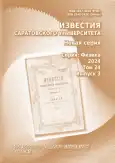Specific features of charge transfer fluctuations in disperse structures based on anatase nanoparticles near the percolation threshold
- Autores: Kochkurov L.A.1, Tsypin D.V.1, Volchkov S.S.2, Zimnyakov D.A.1
-
Afiliações:
- Yuri Gagarin State Technical University of Saratov
- Saratov Branch of the Institute of RadioEngineering and Electronics of Russian Academy of Sciences
- Edição: Volume 24, Nº 3 (2024)
- Páginas: 262-270
- Seção: Solid-State Electronics, Micro- and Nanoelectronics
- URL: https://journal-vniispk.ru/1817-3020/article/view/265417
- DOI: https://doi.org/10.18500/1817-3020-2024-24-3-262-270
- EDN: https://elibrary.ru/RHDYLS
- ID: 265417
Citar
Texto integral
Resumo
Palavras-chave
Sobre autores
Leonid Kochkurov
Yuri Gagarin State Technical University of Saratov77, Politechnicheskaya str., Saratov, 410054, Russia
Dmitry Tsypin
Yuri Gagarin State Technical University of Saratov
ORCID ID: 0000-0001-6873-8018
77, Politechnicheskaya str., Saratov, 410054, Russia
Sergei Volchkov
Saratov Branch of the Institute of RadioEngineering and Electronics of Russian Academy of Sciences
ORCID ID: 0000-0002-3928-8836
Scopus Author ID: 57202159944
Researcher ID: B-7770-2018
38, Zelenaya Str., Saratov 410019, Russia
Dmitry Zimnyakov
Yuri Gagarin State Technical University of Saratov77, Politechnicheskaya str., Saratov, 410054, Russia
Bibliografia
- Witkiewicz Z., Jasek K., Grabka M. Semiconductor gas sensors for detecting chemical warfare agents and their simulants // Sensors. 2023. Vol. 23, iss. 6. Article number 3272. https://doi.org/10.3390/s23063272
- Qin Q., Olimov D., Yin L. Semiconductor-type gas sensors based on γ-Fe2O3 nanoparticles and its derivatives in conjunction with SnO2 and graphene // Chemosensors. 2022. Vol. 10, iss. 7. Article number 267. https://doi.org/10.3390/chemosensors10070267
- Diao F., Wang Y. Transition metal oxide nanostructures: premeditated fabrication and applications in electronic and photonic devices // J. of Materials Science. 2018. Vol. 53. P. 4334–4359. https://doi.org/10.1007/s10853-017-1862-3
- Sudarshan S., Das S., Ray S.K. Progress in groupIV semiconductor nanowires based photonic devices // Appl. Phys. A. 2023. Vol. 129, iss. 3. Article number 216. https://doi.org/10.1007/s00339-023-06483-7
- Terna A. D., Elemike E. E., Mbonu J. I., Osafile O. E., Ezeani R.O. The future of semiconductors nanoparticles: Synthesis, properties and applications // Materials Science and Engineering. 2021. Vol. 272. P. 115363. https://doi.org/10.1016/j.mseb.2021.115363
- Scanlon D. O., Dunnill C. W., Buckeridge J., Shevlin S. A., Logsdail A. J., Woodley S. M., Catlow C. R. A., Powell M. J., Palgrave R. G., Parkin I. P., Watson G. W., Keal T. W., Sherwood P., Walsh A., Sokol A. A. Band alignment of rutile and anatase TiO2 // Nature Materials. 2013. Vol. 12, iss. 9. P. 798–801. https://doi.org/10.1038/nmat3697
- Hanaor D. A. H., Sorrell C. C. Review of the anatase to rutile phase transformation // J. of Materials Science. 2011. Vol. 46. P. 855–874. https://doi.org/10.1007/s10853-010-5113-0
- Tang H., Lévy F., Berger H., Schmid P. E. Urbach tail of anatase TiO2 // Physical Review B. 1995. Vol. 52, iss. 11. P. 7771–7774. https://doi.org/10.1103/PhysRevB.52.7771
- Moser S., Fatale S., Krüger P., Berger H., Bugnon P., Magrez A., Niwa H., Miyawaki J., Harada Y., Grioni M. Electron-phonon coupling in the bulk of anatase TiO2 measured by resonant inelastic X-ray spectroscopy // Physical Review Letters. 2015. Vol. 115, iss. 9. P. 096404. https://doi.org/10.1103/PhysRevLett.115.096404
- Zimnyakov D. A., Volchkov S. S., Vasilkov M. Y., Plugin I. A., Varezhnikov A. S., Gorshkov N. V., Ushakov A. V., Tokarev A. S., Tsypin D. V., Vereshagin D. A. Semiconductor-to-Insulator Transition in Inter-Electrode Bridge-like Ensembles of Anatase Nanoparticles under a Long-Term Action of the Direct Current // Nanomaterials. 2023. Vol. 13, iss. 9. Article number 1490. https://doi.org/10.3390/nano13091490
- Зимняков Д. А., Волчков С. С., Варежников А. С., Васильков М. Ю., Плугин И. А. Особенности макроскопического транспорта зарядов в ансамблях плотноупакованных наночастиц анатаза вблизи порога протекания // Письма в журнал технической физики. 2023. Вып. 6. С. 21–24. https://doi.org/10.21883/PJTF.2023.06.54811.19414
- Кочкуров Л. А., Волчков С. С., Васильков М. Ю., Плугин И. А., Климова А. А., Зимняков Д. А. Деградация проводимости низкоразмерных наноструктурированных полупроводниковых слоев при длительном протекании постоянного тока // Известия Саратовского университета. Новая серия. Серия : Физика. 2024. Т. 24, вып. 1. С. 41–51. https://doi.org/10.18500/1817-3020-2024-24-1-41-51
- Федер Е. Фракталы : пер. с англ. 2-е изд. М. : УРСС ; Ленанд, 2014. 256 с. (Синергетика: от прошлого к будущему; № 69).
- Mercik S., Weron K. Stochastic origins of the long-range correlations of ionic current fluctuations in membrane channels // Physical Review E. 2001. Vol. 63, iss. 5. P. 051910. https://doi.org/10.1103/PhysRevE.63.051910
- Balcerek M., Burnecki K., Thapa S., Wyіomaсska A., Chechkin A. Fractional Brownian motion with random Hurst exponent: Accelerating diffusion and persistence transitions // Chaos: An Interdisciplinary Journal of Nonlinear Science. 2022. Vol. 32, № 9. P. 093114. https://doi.org/10.1063/5.0101913
- Kytin V., Dittrich T., Koch F., Lebedev E. Injection currents and effect of negative capacitance in porous TiO2 // Applied Physics Letters. 2001. Vol. 79, iss. 1. P. 108–110. https://doi.org/10.1063/1.1380241
- Dittrich T., Lebedev E. A., Weidmann J. Electron drift mobility in porous TiO2 anatase) // Physica Status Solidi A (Applied Research). 1998. Vol. 165, № 2. P. R5–R6. https://doi.org/10.1002/(SICI)1521-396X(199802)165:23.0.CO;2-9.
Arquivos suplementares









